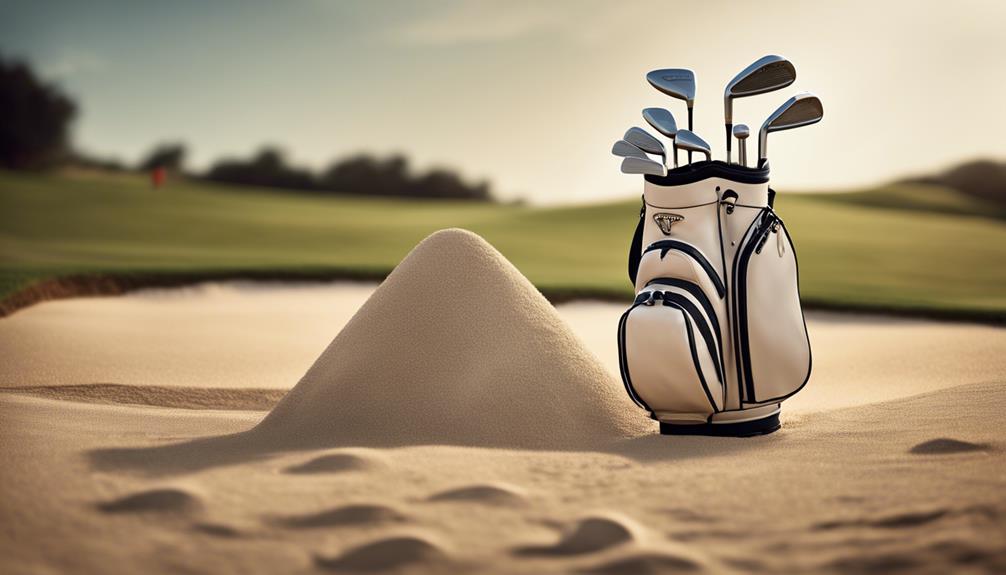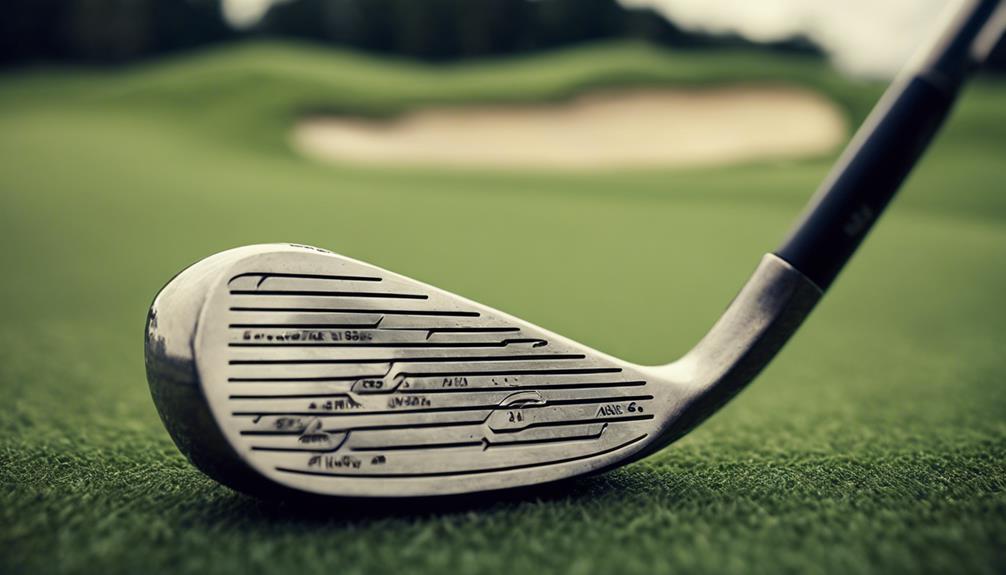- 7 Top Flite Golf Clubs XL for Improved Performance - September 28, 2024
- Top Flite Golf Clubs: Top 5 Reasons to Choose Them - September 28, 2024
- Top 3 Golf Club Fitters for a Perfect Swing - September 28, 2024
When you see the letter 'P' on a golf club, it indicates a Pitching Wedge, a critical club in your iron set designed specifically for approach shots onto the green from 100-120 yards away. With a loft angle between 44-48 degrees, it's ideal for hitting high shots onto the green. As a go-to club for approach shots, it provides precise shots with a moderate to high trajectory. Understanding the PW's purpose is essential for tackling delicate shots around the green. As you explore the world of golf clubs, you'll discover how each club's unique characteristics come together to shape your game.
Key Takeaways
- The letter 'P' on a golf club indicates it's a Pitching Wedge (PW), designed for approach shots to the green from 100-120 yards away.
- PW has a loft angle between 44-48 degrees, making it ideal for high shots onto the green with a moderate to high trajectory.
- PW fills the gap between the 9-iron and Gap Wedge, providing a critical link between irons and higher-lofted wedges in the short game.
- PW is essential for tackling delicate shots around the green, providing precise shots onto the green with a high level of accuracy.
- Mastering the PW helps golfers develop a strong short game, enabling them to tackle specific shots and distances with precision and confidence.
Understanding Golf Club Numbers
When selecting a golf club, you need to understand the significance of the numbers etched onto the club's sole, as they directly impact the trajectory and distance of your shot.
The numbers on a golf club, such as 3-iron or 9-iron, indicate the loft angle, with lower numbers having less loft and higher numbers having more loft.
This loft angle is critical in determining the shot's outcome, with lower loft angles suitable for longer shots and higher loft angles suitable for shorter, higher shots.
As you choose a club from your iron set, consider the loft angle and club type.
For instance, a gap wedge typically has a loft angle between 48-52 degrees, while a lob wedge has a loft angle of over 60 degrees.
Understanding golf club numbers is essential for choosing the right club for a particular shot, as it affects the ball's trajectory and distance.
Purpose of the Pitching Wedge
With your iron set in hand, you'll likely reach for the Pitching Wedge (PW) when facing shots from 100-120 yards away, as its 44-48 degree loft makes it ideal for hitting longest wedge shots into the green.
The PW is your go-to club for approach shots on the golf course, providing precise shots onto the green.
High, accurate shots with a moderate to high trajectory, perfect for shots around the green. A club that fills the gap between your 9-iron and Gap Wedge, providing a critical link between your irons and higher-lofted wedges. A tool for short game mastery, allowing you to hit precise shots with more spin than a standard iron, but less loft and spin than a Gap Wedge or Sand Wedge.
In your short game, the PW is essential for tackling the delicate shots around the green.
With its unique loft and design, it provides the perfect balance of height and spin, making it an indispensable club in your bag.
Types of Golf Club Wedges

You'll typically find four primary types of golf club wedges in a standard set, each designed to tackle specific shots and distances.
These wedges are tailored to help you navigate various situations on the course.
The Pitching Wedge (PW) is your go-to club for full shots onto the green from 100-120 yards, with a loft of 44-48 degrees.
The Gap/Approach Wedge (AW) fills the gap between the PW and Sand Wedge (SW), used for full and partial shots onto the green from 80-100 yards, with a loft of 48-52 degrees.
The Sand Wedge (SW) is designed for shorter chip shots from the rough, not exclusively for bunkers, with a loft of 52-56 degrees.
Finally, the Lob Wedge (LW) is the highest lofted club, used for very short approach shots where the ball needs to go up high and land soft, with a loft of 58-64 degrees.
Mastering each type of wedge will help you tackle specific shots and distances with precision and confidence.
Choosing the Right Golf Club
Selecting the right golf club for a specific shot demands careful consideration of various factors, including loft, lie, and swing style, as the wrong choice can substantially impact your game's overall performance.
You must understand the characteristics of each club to make informed decisions.
When choosing the right club, consider the following key factors:
- Loft: The angle between the clubface and shaft, affecting trajectory and distance. A higher loft results in shorter, higher shots, while a lower loft yields longer, lower shots.
- Lie: The angle between the shaft and the ground, influencing the club's alignment and interaction with the turf.
- Swing style: Your individual swing characteristics, such as tempo and attack angle, which affect the club's performance.
Understanding the different loft, lie, and swing style combinations is essential for selecting the right club for a particular shot.
For instance, a pitching wedge with a higher loft is ideal for shorter shots onto the green, while a lower-lofted club is better suited for longer shots.
Deciphering Club Markings

When examining a golf club, deciphering the markings is vital to understanding its characteristics, and the letter 'P' on a clubhead is a clear indicator that it's a Pitching Wedge, a specific type of iron designed for approach shots to the green.
As you inspect the club, you'll notice the loft angle, which typically falls between 44-48 degrees, making it ideal for hitting high shots onto the green from 100-120 yards away.
This iron is part of an iron set, and its design makes it suitable for full shots onto the green as well as short pitch and run shots around the green.
To master your game, understanding the markings on your Pitching Wedge, including the loft angle and clubhead material, is imperative.
This knowledge will help you make informed club selection decisions, ensuring you choose the right club for the shot.
With a solid understanding of your clubs, you'll be able to navigate the course with confidence, using the right clubs used for the right shots.
Frequently Asked Questions
What Does the P on a Golf Club Mean?
When you see mysterious symbols like 'P' on your golf club, you're likely wondering what they mean. In golf terminology, these acronyms, such as 'P', are iron markings or shaft labels that indicate specific club characteristics, helping you master your equipment inscriptions.
What Is the P System in Golf Swing?
You master the p system in golf swing by understanding how Golf Mechanics, Swing Plane, Body Rotation, Club Face, Ball Position, Posture Alignment, and Backsplash Effect interact, allowing you to optimize Hand Action for precise shots.
What Does 5 Pw Iron Set Mean?
You might think a 5-PW iron set is too limited, but it's actually a thoughtful configuration offering superior iron quality, comprising five clubs (5-iron to PW) designed for forgiveness and consistency, with precise loft angles (44-48°) and shaft materials tailored to your swing speed, ensuring ideal ball flight and distance control.
When to Use a Pitching Wedge?
When you're within 100-120 yards from the green, use a pitching wedge for approach shots, considering pitch shot distance, clubhead speed, ball positioning, and swing tempo to execute a precise green approach, or for bunker shots and lob shots from fairway lies.
Conclusion
Golf club numbers hold the secret to tapping your full potential on the course.
The pitching wedge, a vital club in your arsenal, serves as a bridge between irons and wedges.
With various types of wedges at your disposal, selecting the right one can make all the difference.
Don't get bogged down by club markings – decipher them with ease and watch your game soar.
Remember, mastering your clubs is just a swing away from greatness.




